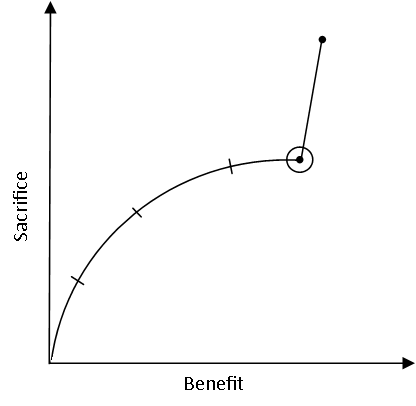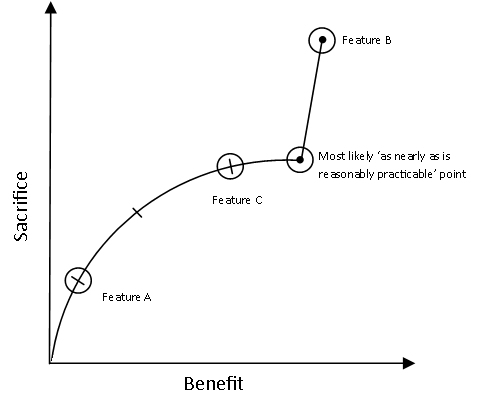Step 3: Applicants assess ANARP for outstanding fire and accessibility Building Code clauses
For buildings subject to either section 112 or section 133AT of the Building Act, assess the 'as nearly as is reasonably practicable' (ANARP) threshold for any outstanding Building Code clauses identified in Step 2, and whether the proposed alteration meets this threshold.
To do this, MBIE recommends that building consent applicants complete, and BCAs consider:
- a gap analysis between the building’s current, full and proposed compliance resulting from the alteration, and
- a weighting exercise to consider the sacrifices and benefits of full compliance.
The considerations made during the gap analysis and weighting exercise should be outlined by the applicant in the consent documentation as evidence that ANARP has been considered sufficiently. BCAs and/or territorial authorities will check this when determining whether or not to grant a building consent for the alteration.
The ANARP threshold will be different for each building, and may be full Building Code compliance. A pre-application meeting is recommended involving the building consent applicant, building professionals (eg architects or designers) and the BCA to discuss the ANARP threshold and design intentions. Ongoing dialogue will be necessary and may result in applicants needing to revise the level of upgrade proposed.
Gap analysis
Knowing what is required to fill the gap between a building’s current compliance and full compliance is essential for determining ANARP.
A gap analysis is recommended, for example:
| Requirement in Acceptable Solution, D1/AS1 | Existing Building(Current compliance feature) | What is needed?(Full compliance feature) | After proposed alteration (Intended compliance feature) |
|---|---|---|---|
| Handrails x2 | 1 | 2 | 2 |
| Tread width/ Riser height |
300mm tread 190mm riser height | 310mm min tread 180mm max riser height | No change |
| Contrasting nosings | None | Required | Installed |
Additional resources
Previous advice issued by MBIE on requesting information about means of escape from fire for existing buildings sets out a scoring method to determine the level of gap analysis required for a building based on certain circumstances. The levels of gap analysis include:
- list of current fire safety features and a statement of changes
- gap assessment using the appropriate Acceptable Solution
- full assessment using:
- an appropriate Acceptable Solution, or
- relevant parts of the Verification Method and other Acceptable Solutions.
This approach can also be applied to the relevant Building Code clauses for accessibility.
Requesting information about means of escape from fire for existing buildings
Weighting exercise
Use the information identified in the gap analysis to assess the sacrifices and benefits of undertaking the remaining upgrades required to achieve full Building Code compliance for fire and accessibility.

This graph illustrates that a point is reached where a significant increase in the sacrifice is made for a comparatively small gain in the resulting benefit. This point can be considered ANARP.
Previous determinations on the above approach are publicly available, specifically determinations 2008/006, 2008/016, 2008/004, 2009/027, 2009/070, 2009/079, 2009/117, 2010/004, 2010/028, 2010/043. Note that determinations are building-specific.
Approaching the weighting exercise
'Sacrifices' include the tangible and intangible costs that a building owner will meet by proceeding with certain upgrades. These can include:
- the direct cost of carrying out upgrades, eg installing a lift or sprinkler system
- factors such as business interruption and loss of amenity values.
'Benefits' include:
- meeting the Building Code objectives for fire and accessibility:
- reduced fire safety risk
- the number of users that will now have access to the building.
An assessment of the benefits and sacrifices should take into account:
- the level of compliance of the existing building with the Building Code clauses relating to fire and accessibility
- the level of upgrade that would be necessary for full Building Code compliance and the cost of compliant construction
- the nature and extent of the alterations, including cost (for example, by a quantity surveyor)
- whether there is any reduction in the level of life safety
- design constraints
- the building size and complexity
- the use of the building, including frequency and nature of occupation, noting that it should always be assumed that disabled people will use the building.

This diagram illustrates the features required for full Building Code compliance relating to Clause D1, using Acceptable Solution D1/AS1. Referring to the gap analysis example above:
- Feature A – handrails
- Feature B – tread width/riser height
- Feature C – contrasting nosings.
In this scenario, the threshold for ANARP is determined as less than full compliance. It requires Features A and C, but not Feature B. Adjusting the tread width and riser height provides little additional benefit compared to the additional sacrifice associated.
Compliance ANARP is achieved if reasonable justification can be provided to establish what the threshold is, and how it is met, including reasoning for why it is less than full Building Code compliance, if applicable. This assessment and justification is best presented in a report.
Key questions to assist with providing this justification include:
- What is necessary to reach full compliance? At what sacrifice?
- What are the options to partly comply? What is the sacrifice vs benefit of partial compliance?
- What is the most reasonably practicable solution?
- Does that solution sufficiently improve the level of compliance given the scope of the proposed building work?
Additional resources
The introduction to 'Requesting information about means of escape from fire for existing buildings' sets out:
- factors that indicate the extent of the proposed building work as minor, moderate or significant, and
- how to consider potential consequences of a building not complying with the Building Code.
This information informs a pragmatic consideration of what a reasonable level of upgrade for fire and accessibility looks like. For example, where the proposed building work is minor, an upgrade such as installation of a lift that costs a significant amount more than the proposed alteration itself is unlikely to be reasonable.
Requesting information about means of escape from fire for existing buildings.
Consider the key factors has more detail on how to use this information.
Although relating to change of use (regarding section 115 of the Building Act), existing advice for temporary business and housing relocations contains some useful information for considering reasonable upgrades in relation to minor, straightforward alterations.
Change of use – meeting the requirements under section 115 of the Building Act 2004.